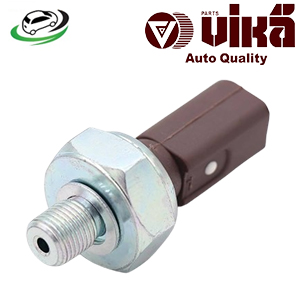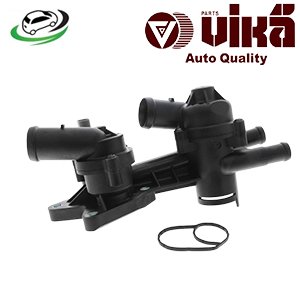-12%
Get Engine Coolant Thermostat Audi A1/A3 (8P1) 1.4 TFSI / VW EOS (1F7/1F8) 1.4 03C121111T
The engine coolant thermostat is a crucial component in an internal combustion engine’s cooling system, responsible for regulating the flow of coolant between the engine and the radiator. Its primary function is to maintain the engine at its optimal operating temperature, ensuring efficient performance, reduced emissions, and prolonged engine life. Here’s a detailed exploration of its function, design, types, operation, and maintenance.
Function and Importance
The thermostat regulates the engine’s temperature by controlling the flow of coolant based on temperature readings. When the engine is cold, the thermostat remains closed, preventing coolant from flowing to the radiator. This allows the engine to warm up quickly. Once the engine reaches its optimal operating temperature, the thermostat opens, allowing coolant to flow through the radiator to dissipate heat and maintain a stable temperature.
Design and Construction
The thermostat is typically housed in a metal or plastic casing and consists of several key components:
- Main Valve: The primary valve that opens and closes to regulate coolant flow.
- Thermostatic Element: A wax-filled or electronically controlled element that responds to temperature changes, causing the valve to open or close.
- Spring: Ensures the valve returns to its default position when the engine is cold.
- Bypass Valve: Allows limited coolant flow when the thermostat is closed to prevent localized overheating.
Types of Engine Coolant Thermostats
There are several types of engine coolant thermostats, each suited to different applications and vehicle designs:
- Traditional Wax-Pellet Thermostats: The most common type, these use a wax pellet that expands and contracts with temperature changes to open and close the valve. As the engine warms up, the wax melts, expands, and pushes the valve open. When the engine cools, the wax solidifies, contracting and closing the valve.
- Electronic Thermostats: These use a temperature sensor and an electronic actuator to control the valve. They offer more precise temperature regulation and can respond more quickly to changing engine conditions, often controlled by the engine control unit (ECU).
- Bypass Thermostats: Designed for high-performance and heavy-duty applications, these thermostats have a secondary valve that allows a small amount of coolant to bypass the radiator even when the main valve is closed, helping to prevent localized hot spots in the engine.
Operation of the Engine Coolant Thermostat
The operation of an engine coolant thermostat can be broken down into several stages:
- Engine Start and Warm-Up: When the engine is first started, it is cold, and the thermostat remains closed. This prevents coolant from circulating through the radiator, allowing the engine to warm up quickly. During this phase, the coolant circulates only within the engine block and the heater core, if the vehicle’s heating system is turned on.
- Reaching Operating Temperature: As the engine warms up, the coolant temperature rises. Once it reaches the thermostat’s set temperature (typically between 180-200°F or 82-93°C), the thermostatic element (wax pellet or electronic sensor) activates, causing the valve to open.
- Regulating Temperature: When the thermostat opens, it allows coolant to flow through the radiator, where it releases heat to the atmosphere before returning to the engine. This flow is regulated to maintain the engine at its optimal operating temperature. If the engine temperature drops below the set point, the thermostat closes partially or fully, reducing coolant flow to the radiator and helping the engine warm back up.
- Continuous Adjustment: The thermostat continuously adjusts the coolant flow to maintain a stable engine temperature, balancing the heat generated by the engine with the heat dissipated by the radiator.
Benefits of Engine Coolant Thermostat
1. Optimal Engine Temperature Regulation
The most crucial benefit of the thermostat is its ability to regulate the engine’s operating temperature. By maintaining the engine within its optimal temperature range, the thermostat ensures:
- Efficient Combustion: Engines operate most efficiently within a specific temperature range. By maintaining this range, the thermostat helps achieve complete fuel combustion, improving fuel efficiency and reducing emissions.
- Reduced Engine Wear: Operating at the correct temperature minimizes thermal stress on engine components, reducing wear and extending the engine’s lifespan.
2. Enhanced Fuel Efficiency
By allowing the engine to reach its optimal operating temperature quickly and maintaining it, the thermostat ensures that the engine runs more efficiently. An engine that operates at its ideal temperature burns fuel more completely, leading to better fuel economy.
3. Reduced Emissions
A properly functioning thermostat helps the engine reach its optimal operating temperature quickly, reducing the time the engine runs in a cold state. Cold engines are less efficient and produce more harmful emissions. By maintaining the correct temperature, the thermostat helps minimize the release of pollutants.
4. Prevention of Engine Overheating
The thermostat opens to allow coolant flow to the radiator when the engine temperature rises above a certain threshold. This helps dissipate excess heat and prevents the engine from overheating, which can cause severe damage such as warped cylinder heads, blown head gaskets, and other critical failures.
5. Faster Warm-Up Time
The thermostat remains closed when the engine is cold, restricting the coolant flow to allow the engine to warm up quickly. This rapid warm-up is beneficial for several reasons:
- Reduced Cold-Start Wear: Engines suffer the most wear during cold starts. A faster warm-up reduces the duration of cold-start conditions, minimizing wear and tear.
- Improved Cabin Heating: For vehicles with a heating system, a faster warm-up means the cabin reaches a comfortable temperature more quickly, enhancing passenger comfort.
6. Stabilized Engine Performance
Consistent engine temperature leads to stabilized engine performance. Fluctuations in temperature can cause variations in engine operation, affecting everything from fuel mixture to ignition timing. The thermostat helps maintain a steady temperature, ensuring smooth and reliable engine performance.
7. Protection of Engine Components
Operating an engine at incorrect temperatures can cause various issues:
- Low Temperature: Running too cool can lead to increased fuel consumption and accumulation of engine deposits.
- High Temperature: Running too hot can cause oil breakdown, reduced lubrication, and damage to engine components such as pistons, cylinders, and the head gasket.
The thermostat helps avoid these extremes by maintaining a balanced engine temperature.
8. Improved Lubrication
Engine oil operates best within a specific temperature range. If the engine is too cold, the oil remains thick and cannot lubricate the engine components effectively. If the engine is too hot, the oil can become too thin and break down. By maintaining the engine at the right temperature, the thermostat ensures that the oil maintains its optimal viscosity, providing better lubrication and reducing engine wear.
9. Increased Engine Longevity
By preventing extreme temperature fluctuations and ensuring the engine operates within its optimal temperature range, the thermostat contributes to the overall longevity of the engine. Consistent temperature control reduces stress on engine components, leading to fewer repairs and a longer engine life.
10. Cost Savings
The combined effects of improved fuel efficiency, reduced emissions, minimized engine wear, and fewer repairs result in significant cost savings over the life of the vehicle. A properly functioning thermostat helps avoid expensive engine damage and improves overall vehicle reliability.
Signs of a worn out Engine Coolant Thermostat
1. Engine Overheating
One of the most obvious signs of a failing thermostat is engine overheating. If the thermostat gets stuck in the closed position, it prevents coolant from flowing to the radiator. This causes the engine temperature to rise rapidly, leading to overheating. Symptoms of engine overheating include:
- The temperature gauge on the dashboard moving into the red zone.
- Steam coming from under the hood.
- The engine warning light turning on.
2. Low Engine Temperature
Conversely, if the thermostat is stuck open, the coolant flows continuously through the radiator, preventing the engine from reaching its optimal operating temperature. Signs of low engine temperature include:
- The temperature gauge on the dashboard stays lower than normal, even after driving for a while.
- The heater produces little or no warm air, especially noticeable in cold weather.
- The engine takes longer than usual to warm up.
3. Erratic Temperature Fluctuations
A malfunctioning thermostat may cause erratic temperature fluctuations. You might notice the temperature gauge moving unpredictably between hot and cold. This inconsistency can be due to the thermostat opening and closing irregularly, affecting the coolant flow and causing temperature swings.
4. Poor Engine Performance
An engine that doesn’t reach or maintain its optimal operating temperature may perform poorly. Symptoms of poor engine performance due to a faulty thermostat include:
- Reduced fuel efficiency.
- Decreased acceleration and overall power.
- Rough idling or stalling, especially in cold weather.
5. Coolant Leaks
A faulty thermostat can sometimes cause coolant leaks. When the thermostat fails to regulate temperature correctly, it can lead to excessive pressure in the cooling system, causing hoses, gaskets, or the radiator to leak. Look for signs of coolant leaks under the vehicle or around the thermostat housing.
6. Unusual Noises
You may hear unusual noises if the thermostat is stuck closed and the engine is overheating. These can include gurgling or boiling sounds from the radiator or coolant reservoir, indicating that the coolant is not circulating properly and is boiling due to excessive heat.
7. Check Engine Light
Modern vehicles are equipped with an engine control unit (ECU) that monitors various engine parameters, including coolant temperature. If the ECU detects an abnormal temperature reading, it may trigger the check engine light. A diagnostic scan can reveal a trouble code related to the cooling system or thermostat.
8. Heater Malfunctions
The vehicle’s heater relies on hot coolant from the engine to produce warm air. If the thermostat is stuck open and the engine is running too cool, the heater may not work correctly, producing little or no warm air even when fully turned on.
Common Issues and Solutions
Several common issues can affect the performance of the engine coolant thermostat:
- Stuck Closed: If the thermostat fails in the closed position, it will prevent coolant from flowing to the radiator, causing the engine to overheat. This is typically due to a faulty wax pellet or mechanical obstruction. The solution is to replace the thermostat.
- Stuck Open: If the thermostat fails in the open position, the coolant will flow continuously through the radiator, preventing the engine from reaching its optimal operating temperature. This can lead to poor fuel economy and increased emissions. The solution is to replace the thermostat.
- Erratic Operation: A thermostat that opens and closes inconsistently can cause fluctuating engine temperatures. This can be due to a failing thermostatic element or electronic control issues. Testing and replacing the thermostat or its electronic components is necessary.
- Leaking Housing: A damaged or corroded thermostat housing can cause coolant leaks, leading to loss of coolant and potential overheating. Replacing the housing or sealing it properly can resolve this issue.
Follow us on Facebook for more parts.



